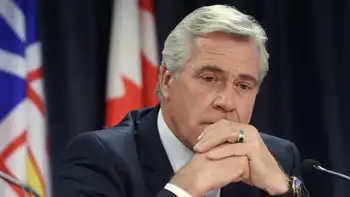Kansas governor announces deal on transmission lines
TOPEKA, KANSAS - Gov. Mark Parkinson announced a settlement between two companies competing to build an ultra high-voltage power line from near Dodge City to Wichita and the Oklahoma border to carry wind power to eastern Kansas and out-of-state markets.
The project is expected to cost up to $800 million, be completed around 2013 and involve some 200 miles of 765 kilovolt transmission lines, the first west of the Mississippi River. Currently, the highest voltage line in Kansas is 345 kilovolts.
The competing proposals were from Prairie Wind Transmission LLC and ITC Great Plains. Prairie Wind involves Topeka-based Westar Energy Inc., the state's largest electric utility, and ITC is a Topeka-based subsidiary of a Michigan transmission company.
Parkinson said both companies wanted to build the line, resulting in several months of negotiations after Prairie Wind and ITC each sought approval from the Kansas Corporation Commission. Those talks led to the agreement signed by the various parties in the governor's office.
"Without a settlement the project itself was in jeopardy. At a minimum it would have been delayed two or three years depending on how long the litigation have taken," Parkinson said. "It not only drastically reduces the amount of time that this project will take but it also significantly reduces the possibility that this project would have been scrapped altogether."
House Utility Committee Chairman Carl Dean Holmes, a Republican from Liberal, said the settlement was noteworthy for another reason.
"This may be the first time in Kansas history that companies have competed to building much-needed transmission capacity," said Holmes, who's also chairman of the Kansas Electric Transmission Authority.
Under the settlement, Prairie Wind will build and operate a section from Wichita to Medicine Lodge and then down to the Oklahoma border, where it will join that state's ultra high-voltage line.
ITC's section will start at Spearville, near Dodge City, and go through Comanche County to Medicine Lodge. When completed, the projected will resemble a Y.
The ultra high-voltage line will allow for more electricity to be carried which means less energy loss in transmission and allow for additional electrical power to move from the additional wind farms that will be built in western Kansas.
"We absolutely must have a way to move the great wind energy source that we have in western Kansas to eastern Kansas and beyond," the governor said.
There are other steps that have to be completed before the project can get under way.
The KCC, whose staff help broker the deal, will have hearings in July to consider the proposal, which it could accept, reject or modify. KCC spokeswoman Abbie Hodgson said it probably will be late summer or early fall before a decision is made.
There's also the question of who pays for it. The Southwest Power Pool, based in Little Rock, Ark., the regional transmission organization for Kansas and surrounding states, will decide how the costs are recovered.
"In order for this line to be built or any transmission line that moves power to other states, we need others states who also are beneficiaries of that power to pay for part of that transmission," Parkinson said.
Last month, Parkinson signed a renewable energy bill that he had demanded from legislators as part of an agreement allowing construction of a coal-fired power plant near Holcomb in southwest Kansas.
That legislation requires that wind farms and other renewable sources must provide 20 percent of public utilities' electricity by 2020. It also has provisions to encourage conservation and consumers' use of small wind or solar generators for their household power needs.
Related News

Energy UK - Switching surge continues
LONDON - More than 600,000 customers took steps to save on their energy bills this winter by switching electricity provider in October, the latest figures from Energy UK reveal.
A third (32 per cent) of those changing providers in October moved to small and mid-tier suppliers.
With recent research showing that that nine in ten energy switchers were happy with the process of changing suppliers and with the reassurance provided by the Energy Switch Guarantee - a series of commitments ensuring switches are simple, speedy and safe - more and more customers are now confident when looking to move.
Lawrence Slade, chief executive of Energy UK said:…




